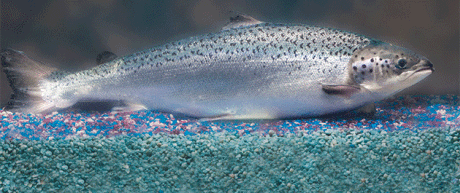FDA Approves Genetically Modified Salmon For Human Consumption
In addition, the FDA found that approving the GE salmon would not have a significant environmental impact
 Photo courtesy of the FDAAfter an exhaustive and rigorous scientific review, the U.S. Food and Drug Administration has arrived at the decision that AquAdvantage salmon is as safe to eat as any non-genetically engineered (GE) Atlantic salmon, and also as nutritious.
Photo courtesy of the FDAAfter an exhaustive and rigorous scientific review, the U.S. Food and Drug Administration has arrived at the decision that AquAdvantage salmon is as safe to eat as any non-genetically engineered (GE) Atlantic salmon, and also as nutritious.
FDA’s Review of the GE Salmon
The FDA scientists rigorously evaluated extensive data submitted by the manufacturer, AquaBounty Technologies, and other peer-reviewed data, to assess whether AquAdvantage salmon met the criteria for approval established by law; namely, safety and effectiveness. The data demonstrated that the inserted genes remained stable over several generations of fish, that food from the GE salmon is safe to eat by humans and animals, that the genetic engineering is safe for the fish, and the salmon meets the sponsor’s claim about faster growth.
In addition, FDA assessed the environmental impacts of approving this application and found that the approval would not have a significant impact on the environment of the United States. That’s because the multiple containment measures the company will use in the land-based facilities in Panama and Canada make it extremely unlikely that the fish could escape and establish themselves in the wild.
Labeling Food Containing Ingredients Derived from Genetically Engineered Sources
At the same time, many consumers also want to know whether their food or any ingredients in their food is derived from genetically engineered sources. Although the law does not require food containing ingredients derived from these salmon to be labeled as GE, FDA recognizes that many consumers are interested in this information, and some food manufacturers will want to make the distinction.
FDA is releasing two guidance documents detailing the agency’s current thinking on labeling—a draft guidance for labeling of food derived from Atlantic salmon that has or has not been genetically engineered and a final guidance for labeling of food that has or has not been derived from GE plants—to help those manufacturers who wish to voluntarily make the distinction on the labeling of their food products.
“Both guidance documents explain FDA’s best thinking on how to make it easy for consumers to know whether a food was produced using genetic engineering or not,” says Felicia Billingslea, B.S., M.S., director of FDA’s Division of Food Labeling and Standards.
The public is invited to provide comments on this draft guidance. Consumers can also learn more about how a food is produced by contacting the manufacturer, Billingslea says.
